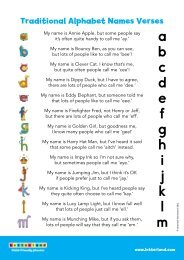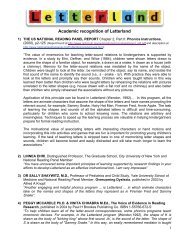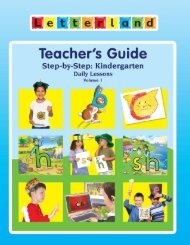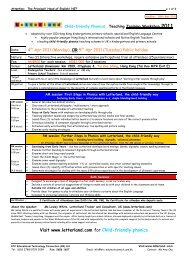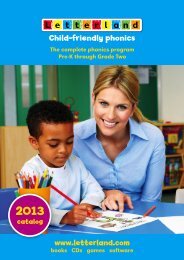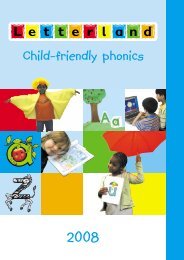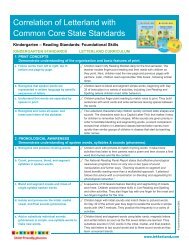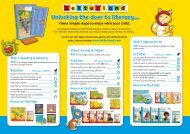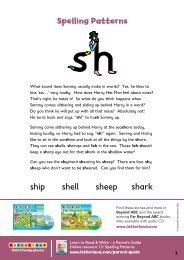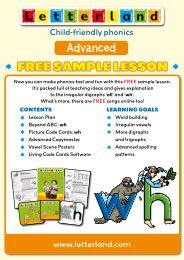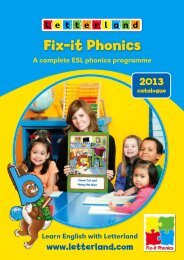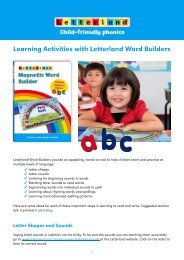Teacher's Guide - Letterland
Teacher's Guide - Letterland
Teacher's Guide - Letterland
You also want an ePaper? Increase the reach of your titles
YUMPU automatically turns print PDFs into web optimized ePapers that Google loves.
© <strong>Letterland</strong> International Limited. All rights reserved.Multi-sensory Activitiesfor Blending andSegmenting WordsThese activities provide actions for children touse as they blend and segment words. Along withusing their voices, mouth movements, eyes andears, the hand movements provide Visual-Auditory-Kinesthetic-Tactile (VAKT) stimulationas children blend and segment sounds to read andspell words. Also, active use of their hands helpsto focus children’s attention and lets you observetheir level of participation unobtrusively.You will use these actions with children inseveral of the whole group and small groupactivities during the five day Unit. Usually, youwill make the motions with them unless you wantto observe one or more children’s actions withoutteacher support. In addition, you will want toencourage your children to use these methods asneeded when they are independently reading orwriting.As they touch the parts of the arm they say thesounds or phonemes of the word. They mayrepeat the sounds touching each part of the armagain (this aides in holding the sounds inmemory).• Next children slide the right hand from theshoulder to the inside of the elbow as they blendthe first two sounds. Then they touch at the wristand say the last sound.• Then children slide the right hand all the wayfrom shoulder to wrist as the sound of the firsttwo with the third sound.• Usually you will want children to repeat theblended word in a quicker, more naturalsounding way as they quickly slide their handsdown their arms again.• It is a good idea to use the word in a quickphrase or sentence to make sure everyoneunderstands the word.mmmăăăpActivities for BlendingSounds to Read a WordUse the activities described below when theobjective is to read an unknown decodable word.They are valuable in Live Reading, reading wordsmade with Picture Code Cards, and anytime thechild needs to sound out an unknown word.The Rollercoaster Trick (Arm-Blending)The Rollercoaster Trick (arm-blending) involveslarge movements with both arms and should beused when first teaching children to blend.Children in kindergartens using <strong>Letterland</strong> Stepby-Stepwill have learned this technique and mayhave already ‘graduated’ to Finger Sounding(below). Children already using Finger Soundingmay need to revert to the Rollercoaster whenblending new types of spelling patterns (especiallywhen they are introduced to consonant blends inUnits 11-15).Basic Procedure• Children look at the letters in the word and thenput the sounds of the word on their arm (forthree sound words, this usually means touchingthe right arm, first to the left shoulder, then tothe inside of the elbow, and then to the wrist.)mmmăăăp,mapFinger SoundingFinger Sounding serves the same purpose as theRollercoaster, but it involves smaller, quickermovements. Once you are sure children areconfident at blending sounds, you may want themto use mostly Finger Sounding to read anyunknown words.• Finger Sounding can be done in two ways:1) Finger Pop-Ups 2) Finger Tapping.• In both methods of Finger Sounding, each fingerrepresents one phoneme. So in words withdigraphs such as the ch in much, the digraphonly gets one tap. Much is tapped with threefingers. Other consonant digraphs such as ck, sh,th, wh, kn, and ph also all receive only one tap.• The same one-tap-per-sound applies to voweldigraphs such as ee, ea, ai, ay, oo, ow, andmany more.34



